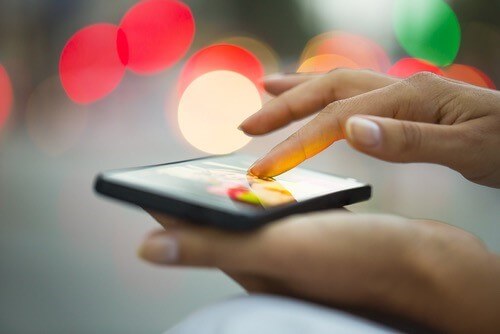Why We’re Addicted To Our Smartphones, But Not Our Tablets
Remember all of the wisecracks about executives and their BlackBerry addictions? Back then, constant contact was limited to the few and the mighty — relatively speaking, of course. But now, the last laugh might be on us. In record time, our smartphones have become indispensable, and as mobile technology has become integrated into nearly every aspect of our lives, our smartphones are shifting from device to dependency.
But while it’s now clear that we are locked in an intense relationship with our smartphones, one has to wonder why this courtship hasn’t turned into a love triangle with tablets. After all, no matter how sleek our iPhone 6 is, our iPad or Android tablet is equally smooth and packed with life-organizing apps.
So, what is it about our smartphones that makes them so attractive? And why is the addiction we feel toward them so much stronger than to our tablets?
Old Habits Die Hard
The average mobile phone user checks their device 150 times a day, and a recent study cited that 94% of college students reported feeling troubled when not carrying their phones with them. 80% of them said they felt jealous when someone else held their phones, and 70% said they expected to have feelings of depression, panic and helplessness if their phones were lost or stolen.
Tablets don’t trigger such intense emotions because, although they have all of the bells and whistles needed for them to be classified as mobile devices, we tend not to see them in that way.
According to Salesforce’s “2014 Mobile Behavior Report” (PDF), just 14% of consumers associate tablets and e-readers with the word “mobile.” Instead, the tablet is regarded largely as an in-home device that lends itself well to cross-device usage. People who own both a smartphone and a tablet don’t spend any less time using their smartphone than those who don’t own a tablet, which means that we regard them as filling different functions. They aren’t interchangeable, despite their similarity in function and design.
The adage “old habits die hard” has a neurological basis. Behaviors turn into habits when they become automatic. Do you lock your door without thinking or find yourself brushing your teeth without even remembering walking into the bathroom? Those are habits. But when do habits turn from harmless to harmful?
When you perform a specific behavior regularly and often, its pattern becomes etched in your neural pathways. Smartphones are designed to get us to check them repeatedly — new emails, text messages and Facebook updates beckon throughout the day, urging us to constantly pull the device out of our pocket. This behavior — checking the screen — quickly becomes habit by nature of its routine. But when that habit turns from a want into a need — meaning we start to feel anxious or disconnected from the world around us if we don’t check the phone — then the action morphs from habit into reflex.
There’s also a feedback loop at play here with our smartphones. When a certain behavior makes you feel good, you will return to it again and again. So, if playing a game on your smartphone tends to relax you when you feel stressed, then the pleasure or comfort brought on by the game — the positive feedback from indulging an urge — encourages repetitive behavior.

Zooming in on our neurological pathways, the difference between a habit and an addiction is the development of intolerance. According to the American Society of Addiction Medicine, behavioral addictions are mapped out the same way in the brain: Both cause a high or “buzz,” brought on by that positive feedback loop, and both can produce feelings of withdrawal if they are not indulged. Do you whip out your smartphone when you feel bored, lonely or anxious in order to squelch those feelings? Be careful: In doing so, you are building strong neurological connections between the urge to check your phone and the buzz-like relief of doing so. Repeat those actions enough, and soon the casual updating of your Facebook status will become something much more urgent.
Speaking of buzz, websites like Buzzfeed use exactly that model to keep users engaged through associative linkage — linking one idea to the next through casual associations. Visitors on Buzzfeed (or Bored Panda or Facebook…) generally don’t have a specific goal in mind; rather, they’re looking for amusement or a break. They can be engaged by links to similar content at the bottom of each article, leading them to jump from one article of interest to the next.
When Want Becomes Need
All great love stories carry the same refrain: the enamored duo looks longingly at each other and thinks, “How did we ever live without each other?”
With your smartphone, there’s a similar — but more sinister — pattern. The more you use your phone, satisfying your hungry neurons with the positive feedback of constant connectivity, the more you wonder how you ever lived without it.
We use our tablets a lot, too, but when we pick them up and handle them, they feel different to us than our phones do. The phone has come to represent our portal into the social world, signifying connectivity to all that is happening outside and around us. It sits in our pocket or our purse, sending and receiving signals and acting as a crucial link that anchors and moors us via its messages, social networks and constant texts. We have come to feel that our phone is like an extension of our body, which is why, when you forget it at home one morning, you have that same sinking feeling you might get if you looked down and realized one of your limbs was missing.
Tablets, however, are used not in “connection mode,” but rather in “browsing mode.” We tend to use our tablets for passive activities, like watching videos and reading books, so that crucial feedback of connection and community that our phones provide is left out of the equation. What we are addicted to with our phones is the way they make us feel in relation to the outside world. According to research, our tablets, however, are used for more personal, solitary endeavors, making the neurological response to their presence entirely different.
A Vacation From Stimulation?
The online world is packed with stimuli — emails, chats, popup ads and the nonstop churn of online news. There’s just no way the real world can compete; and by constantly checking our messages and scrolling through news feeds, we set a new baseline for neurological stimulation that the real world can’t possibly keep up with.
All of this constant stimulation comes with a price. “Every time you switch your focus from one thing to another, there’s something called a switch-cost,” says Earl Miller, professor of neuroscience at MIT. “Your brain stumbles a bit, and it requires time to get back to where it was before it was distracted.”
According to a recent study, the brain can take from 15 to 25 minutes to get back to where it was after stopping to check an email, and even though you could “fix” this by simply switching your phone or notifications off during work, your brain is still hooked on having to check the phone.
For us, designers and developers, these facts can be harnessed for good. Obviously we can’t know how users are going to access your sites, but in many cases, they will be in browsing mode. The experience in this case is instant; it’s here and now. They’re in connection mode during their spare time and will end up purchasing if the product is exciting enough.

If you own a smartphone, chances are your brain pathways are already showing some signs of dependence. So, the next time you are tempted to snicker at the Google Glassholes or the BlackBerry addicts, take a look in the mirror — a real mirror, not an app on your phone — and ask yourself whether your own relationship with your smartphone is healthy.
Conclusion
When designing content, keep in mind that smartphones and tablets activate different mindsets. So, match the experience of each device to the particular mindset it activates. Research claims that users are in “connection mode” while using smartphones and in passive “browsing mode” while on their tablets. There are exceptions of course, and we have to keep them in mind, but we are certainly more connected to phones than to tablets, and that’s something we should keep in mind when crafting cross-browser experiences.
Further Reading
- How To Design For Android Tablets
- Are Touchscreen Tablets Effective Design Tools?
- 10 Things To Think About When Designing Your iPad App
- Transform A Tablet Into An Affordable Kiosk For Your Clients




 JavaScript Form Builder — Create JSON-driven forms without coding.
JavaScript Form Builder — Create JSON-driven forms without coding. Get a Free Trial
Get a Free Trial Try if for free!
Try if for free!



